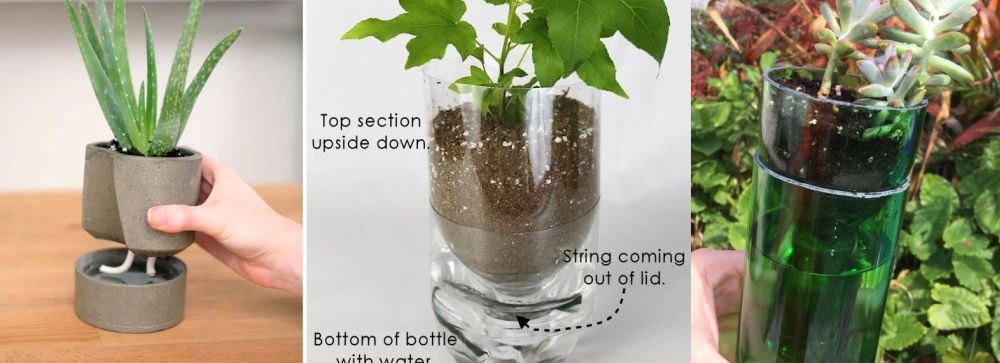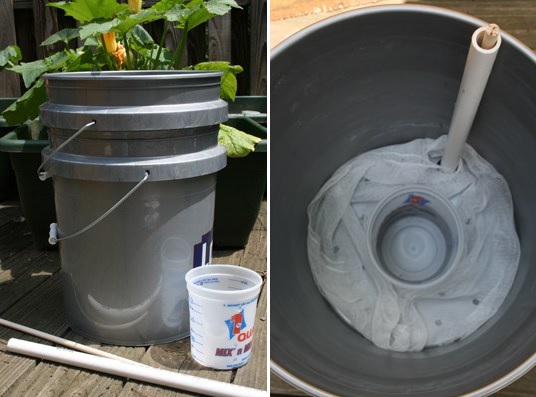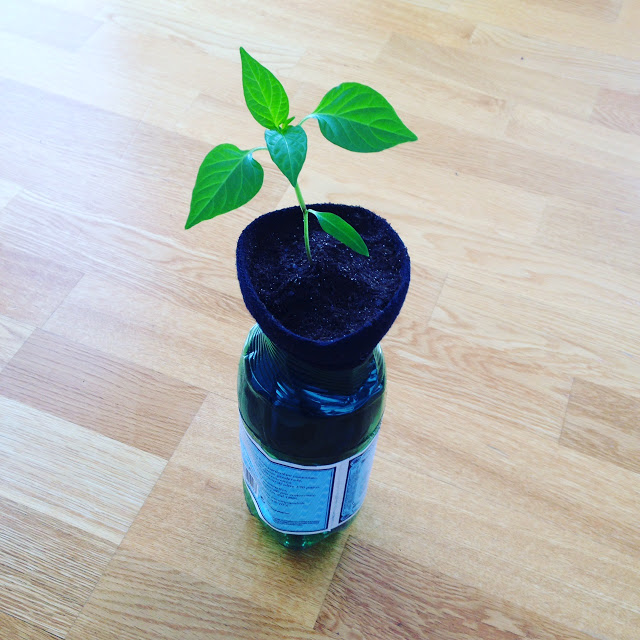Self-watering planters are great for many reasons. They’re low maintenance and don’t require too much of your time. When you’re away from home for an extended period, your plants will need water.

A self-watering planter is just the thing for those who travel often. You can feel secure knowing that your plant will be able to drink water when you’re not home.
DIY self-watering planters are a solution for when you want to go on vacation and want to keep your plants healthy while you’re away.
You can buy a self-watering planter, but it wouldn’t be worth the price when compared to a DIY self-watering mechanism.
In a rush? Here’s a rundown of self-watering planters.
- Do Self Watering Planters Really Work?
- How Do I Make My Planters Self Water?
- Do You Put Rocks in the Bottom of a Self Watering Planter?
- Best Plants for Self Watering Pots
- Pros and Cons to Using Self Watering Planters
- How to Make a Self Watering Herb Planter Box
- 20 Quick and Simple DIY Self-Watering Planters
Self Watering Planters
For indoor gardeners who want to save water, a self-watering pot is ideal. The watering system has an overflow system that helps prevent root rot. The planter has a drainage hole where excess water collects at the bottom that drains the water so your plants stay healthy.
The planters also use exact water amounts, thus reducing water waste. Meanwhile, there are some self-watering planters that have a built-in moisture-wicking system.
Self-watering planters provide your greenery with nutrients, food, and water. The slow release of these nutrients will allow them to thrive for three or four weeks by themselves.
How Do Indoor Self Watering Planters Work?

A container that bills itself as “self-watering” doesn’t water itself. If you live in a hot climate, you’ll want to be careful your water doesn’t evaporate after you’ve made new indoor self-watering planters.
The system comes with a water reservoir at the bottom of the container. Water is provided by means of a soil “foot” or a fabric “wick” connected to the area where the plant is.
Plants grown in a soil foot system will send roots to the foot and take up water when necessary. The water is moved through the wick and into the soil of the main pot with the wick system, a capillary action system. Either way, they will have access to water as long as there is water in the reservoir.
DIY Special – 20 Best Self Watering Planters
Here are the 20 best self-watering planters you can make by yourself. To compile this list, our editors independently research and test every item.
1. Recycled Bottle Self Watering Planter

DIY self-watering planters on our list are made from recycled bottles. The tutorial from craftyourhappiness shows how you can make such a planter out of nothing but a plastic bottle and a piece of string.
Cut the bottle into two sections, make a hole in the cap and run the string through, put a few stones and soil into the top section, add the plant and then place this upside down into the bottom half of the bottle which is filled with water.
2. Self Watering Concrete Planter

This self-watering planter has two parts: a water reservoir at the bottom and the planter at the top. A hole in the bottom features a wick. The wick absorbs water, allowing it to seep into the soil. The self-watering pots are easy to make with molds and concrete mix.
To learn more, check out the details on instructables.
3. Self Watering Downspout Planter

DIY self-watering planters pots have the same structure. The pot has a reservoir filled with water and a planter that sits on top and receives water from the reservoir through small holes or a wick. The self-watering downspout planter featured on instructables isn’t different. With this planter, remember to fill the reservoir.
4. Glass Bottle Self Watering Planter

Plastic bottles are easy to cut, but if you want a stronger self-watering planter, you might want to use a glass bottle. When cutting glass bottles, you’ll need a bottle cutter.
This project is easy, and even with this extra step. You can use a green-tinted wine bottle that would match your plants and still be heavy and sturdy enough to last for a long time.
5. Herb Bottle Gardens

DIY containers are good for herb gardens. They are small enough for windowsills and large enough for plants to have enough room for growth. The ones suggested on designsponge are made out of recycled bottles that could be beer or wine bottle tops.
6. Sports Top Water Bottle

To make it even easier to craft a self-watering planter out of a bottle, choose one that has a sports top. You won’t need to add a string to make a hole in the map. You’ll also need aquarium gravel, soil, a plant, scissors, and dried moss. Follow the instructions on thechillydog.
7. Large Self Watering Planter

After you’ve seen the ideas we’ve gathered so far, you might be wondering if there’s a way you could make a large plant pot like the one here. Check out bucolicbushwick to find out how you can convert a standard one into a self-watering one.
8. Outdoor Self Watering Planter

If you need an industrial-size self-watering mechanism for outdoor use, a large plastic container would be just the thing. When it rains, all you do is move it into your garage. If you like the idea of a large planter with a big reservoir, then watch this tutorial at frugalupstate.
9. Bottle Self Watering Planter

There’s more than one way to connect a pot to a water reservoir. The idea with the bottle planter with a hole in the cap and a wick is simple. However, there’s another strategy that you might want to try. Check out this idea from instructables.
10. Self Watering Planter Pot

Another tutorial showing you how to build one can be found on thehandygardener. The supplies needed include a foam box with no holes and with a lid, PVC pipe, saw, scissors, waterproof tape, and a stick. The stick serves as a water level indicator.
11. Water Cooler Bottle

The idea of up-cycling water bottles is great because you can make them of all shapes and sizes, depending on the size and shape of the bottle. If you need a large one then use a water cooler bottle. It should offer a big water reservoir that will take care of your plants.
The tutorial on bucolicbushwick suggests using a tomato cage as a support structure.
12. Self Watering Planter At A Low Price

With large pots, you can use buckets instead of big bottles. According to the tutorial on reallifeathome you can make one using two paint buckets, a paint mixing container, PVC pipe, dowel, and a drill. You’ll need coffee filters or a cheesecloth to cover the holes at the bottom of the bucket so the soil doesn’t block them.
13. Customized Self Watering Planter

You can use any type of pot or container to build one. It’s a matter of adjusting your design to the supplies and tools. Check out littlevictorian to find out how this process works.
14. Self Watering Container Garden

It’s possible to build this from almost anything. Check out this project from verticalveg. The planters are made of wood boxes, plastic sheets, pipes, and containers. They provide access to water so your plants, herbs, and succulents will have plenty to drink. Plus, your roots will always stay hydrated.
15. Self Watering Planters for Tomatoes

Thanks to designs like this one you can grow vegetables without a garden. You can make one like this for less than $10. All you will need is a towel, two containers, and two sponges. You can find all the details plus instructions and tips in this Youtube video tutorial.
16. Mini Self Watering Wicking Garden

This is a great option for a green thumb who is short on space, and this wicking bed container garden is simple enough for anyone to create. Follow this tutorial on YouTube for more details. The system will save water, provide just the right amount of moisture, keep your plant’s roots hydrated, and most of all, it’s easy to build.
You could even get your kids involved in this project, and it’s ideal for anyone who lives in an apartment or who is an urban gardener. Your new garden setup should last for a few years, and you’ll just have to replace the fabric on the bottom from time to time.
17. Self Watering Container With Buckets

You’ll need two buckets and a Styrofoam cup to form the base of this container. You can find buckets at crestonesolarschool or a local grocery store for a low price. Try to get two different sizes and depths to be able to make this one.
The shorter one will hold the plant, and the larger one will be used for your water reserve. The Styrofoam cup should be large if you have a deep water reservoir but can be small if it’s shallow.
This is a fun and easy project to create, especially in comparison to other options, and it’s a great choice for anyone going away for an extended to keep your plants healthy.
18. Self Watering Garden With Air Conditioner

For an eco-friendly option that uses your air conditioner’s recycled water, check out this garden from instructables. It will lower water expenses, plus you won’t have to worry about watering after everything is set up.
19. One Cut Soda Bottle Self Watering Planter

For this simple DIY project, you’ll need a 2-liter bottle and an old sock. It requires one cut in the bottle, and then push the end of the sock through the bottleneck.
The elastic band in the sock will keep it in place. It’s ideal for indoor use, as you’ll fill the sock with dirt and add a plant of your choice as described here: planteatrepeat.
20. Self Watering Planter With Any Container

Use a container of your choice to create this one from thekitchengarten. Options include a Rubbermaid tub or a decorative container if you want to make this a focal point. You could use any large container, even one not designed for plants. It’s also ideal for salad leaves. You can watch them bloom within weeks.
How Much Water Do Self Watering Planters Need?
A self-watering mechanism comes with a water level window. When you can’t see water in the window, that’s when you know your water level is low. Regular sizes need water every week or two.
Market research has found that self-watering planters do not work for all plant species. They work best for tropical plants and vegetables. Here are a few indoor plants that either benefit or shouldn’t be used with a self-watering system.
Snake Plants
Snake plants need water when their soil is dry. During the summer, water them once every 15 days. When one inch of the soil is dry, add half a cup of water for small plants. Add one cup for medium sizes and one and a half cups for larger ones. House plants do not need to be watered year-round. During the winter they only need to be watered once a month.
Spider Plants
Water spider plants when 50 percent of the topsoil is dry. Add enough until it flows through the hole at the bottom of the pot. You’ll need to keep the plant in an area where there is plenty of sunlight.
Tomato Plants
Tomato plants should receive one or two inches of water each week. Also, the best time to water is in the morning. The planter works best when the soil quality is poor.
Aloe Plants
With aloe, you should avoid this self-watering mechanism. The last thing you want to do to aloe house plants is give them too much water.
Jade Plants
A jade plant is an indoor succulent, which means they don’t need much water. A self-watering planter would not be suitable as it would give the jade too much water.
Best Plants For Self Watering Pots
The pots are ideal for anyone who has a habit of forgetting to water their indoor greenery. However, they aren’t just for those who forget about their gardens. They are ideal for plants that dislike being watered by hand, such as succulents and cacti.
Here are five species you can grow in self-watering pots.
1. Pothos Or Devil’s Ivy

A Pothos plant flourishes in a self-watering pot for several reasons. Root rot can be avoided, a condition this plant suffers from owing to a lack of water or excessive irrigation.
Too much water can result in fungal diseases and drooping. It’s best to use a self-watering pot. Allow them to dry before replenishing the reservoir.
People will top-dress Pothos with new dirt in the visible gaps.
2. Ferns

Ferns thrive when they are provided with moisture and humidity, and planted in peaty soil. Using water at room temperature will help to ensure their health.
Ferns die from a lack of moisture and too much water. When ferns do not receive enough water, their leaves turn yellow and they become dry. Overwatering can result in the rotting of plant roots and fading foliage.
A fern’s moisture requirements should be monitored on a regular basis. Avoid adding water from the top after they’ve been planted in a pot.
3. Cherry Tomatoes

Large containers are ideal for cherry tomato plants. They allow space for water absorption. The plants require more water. Little water will cause end rot and split produce. To remain healthy, give it consistent water and nutrients.
You want to prevent overwatering. Although the soil must be moist, this does not imply it must be humid.
4. Umbrella Palm

Umbrella palms need more water than most plants. The species is a semi-aquatic plant. An umbrella palm planted in a self watering pot will thrive.
Because the plant thrives in water, fill the reservoir and replenish as needed. If it’s denied access to water, it will dehydrate. When that happens, brown stains will appear on the tips of the leaves.
5. Basil

Basil requires sunlight and mild temperatures to grow. When the weather is hot and dry, it will grow well. When it gets cold, it may not withstand the weather.
To avoid such issues, grow the plant in an atmosphere conducive to growth. Growing basil indoors, either under a grow light or placed on a windowsill will help it grow faster.
Frequently Asked Questions (FAQ)FAQ
How Do Self Watering Hanging Baskets Work?
Self-watering hanging baskets are like others. You’ll need a growing bed, potting soil, water reservoir, and a wicking system that puts dirt in contact with water. The baskets use capillary action or “wicking.” When the roots absorb water, the soil wicks up to maintain moisture.
Do Self Watering Planters Attract Mosquitoes?
Yes, they do. They’re the ideal breeding grounds for mosquitoes. Because of their constant moist conditions, it’s easier for them to lay eggs. To prevent mosquitoes, flush the water out every few days.
What Happens When The Reservoir Dries Out?
If you don’t keep water in the plant pot reservoir it will cause the wicking system to dry out and it won’t work when you refill the reservoir. If you allow the reservoir to dry, you will need to water it from the top, soaking the dirt with the wicking system at the bottom of the plant pot.
Can You Put Rocks At The Bottom Of A Self Watering Planter?
Gravel should not be used to line the bottom. The mechanism allows water to travel to the plant roots when needed, rather than when the pot is dry. This is known as capillary action. Those who think that rock layers on top of fabric wicks should know they will take up space in the reservoir.
Self Watering Planters Conclusion
Self-watering pots are the best way to keep your greenery healthy. Self-watering plant pots are the best indoor option for taking care of your plants. The planters offer just the right amount of water for your house plants. They’re also a great option to keep your herbs growing and do not require you to add water yourself.
For the best budget, you can’t go wrong with DIY self-water pots. They’re easy to make, plus buying self watering plant pots aren’t worth the price. Unlike other self-watering planters, DIY planters help minimize household waste and remain the best indoor option to take care of plants.
The post Self Watering Planters: 20 DIY Ideas To Keep Your Greenery Healthy appeared first on Home Decorating Trends - Homedit.


0 Commentaires